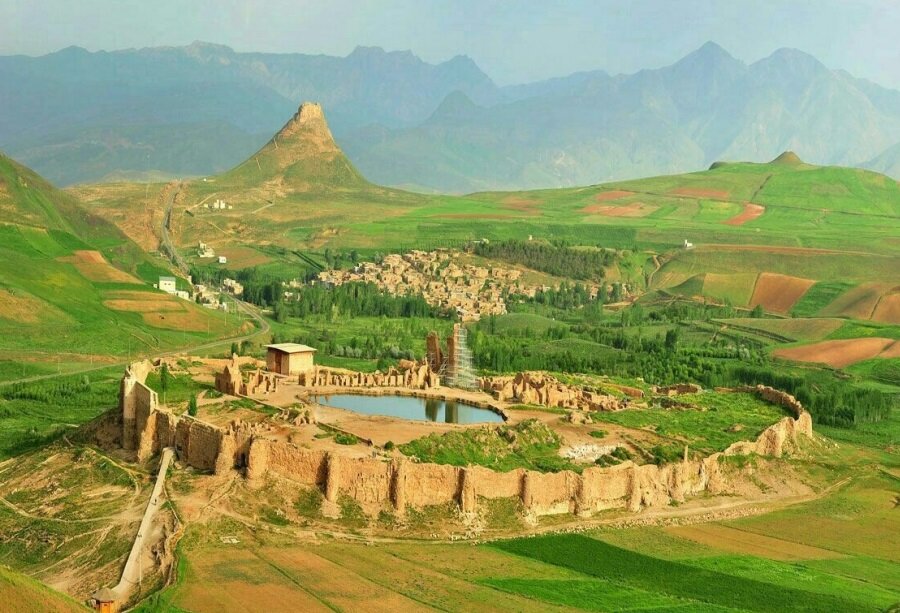West Azarbaijan’s Nowruz tourism peaks at Takht-e Soleyman

TEHRAN – On Thursday evening, West Azarbaijan’s director-general of tourism announced that Takht-e Soleyman, a UNESCO-listed site, has hosted the highest number of visitors in the province in the course of the Nowruz holidays.
During a provincial travel facilitation meeting, Morteza Safari highlighted that from March 14 to April 1, Takht-e Soleyman in Takab had the highest number of visitors, among the historical sites within the province, followed by Baghche Jug Palace Museum, Ethnology Museum, Archaeology Museum, and Se-Gonbad Tomb Tower in subsequent ranking.
Detailing the foot traffic to the historical, cultural, and natural attractions and museums, Safari pinpointed that the visits have grown by 29% to 1,611,667 people during this period.
“During Nowruz, most travels are towards the southern regions of the country and tropical areas,” Safari noted, “unfortunately, in previous years, significant investment has not been made in the necessary infrastructure to attract tourists.”
He also pointed to a positive and growing trend in attracting investment and prospering tourism across the province which started in recent months.
Citing an example of taking steps forward to overcome obstacles, the official mentioned the Urmia cable car project as one of the important tourism projects, which, upon completion, will play a significant role in attracting tourists.
“So far, most of the problems related to this project have been resolved by activating it,” Safari added.
He stated that the provincial travel agents had been prepared to host Nowruz travelers through more than 40 meetings over recent months, expressing gratitude to the 27 member organizations of the headquarters.
He also mentioned that several important historical buildings, including Ansari House and Hedayat School, have been handed over to the Cultural Heritage, Tourism, and Handicrafts Department of West Azarbaijan, playing a significant role in attracting tourists.
“In this regard, this year, more than five thousand people visited the Hedayat School Handicrafts Museum in Urmia during Nowruz…,” the provincial tourism chief noted.
Providing a comprehensive overview of accommodation statistics across the province, Safari outlined that with a 17% growth, 123,821 people stayed in provincial accommodation centers from March 14 to April 1, and the occupancy rate of accommodation beds was 44%, which saw a 10% growth in comparison to the past year’s corresponding time.
The official also stated that there have been hundreds of supervisory visits to ensure the best travel experience for holidaymakers.
In his concluding remarks, Safari mentioned some other measures taken to improve the quality of services provided to travelers in this year's Nowruz plan featuring, the improvement of roadside complexes and accommodation facilities, establishment of 18 handicraft markets with 192 booths, holding Nowruz events in 43 locations, operation of dozens of tourism buses with a 33% growth and implementation of the temporary accommodation plan.
It is also noteworthy that the UNESCO-designated site of Takht-e Soleyman became West Azarbaijan’s top destination throughout the Nowroz holidays.
Takht-e Soleyman, which literally means “the throne of Solomon”, is now a major travel destination for domestic and foreign travelers.
The ceremonial complex encompasses a lake roughly 80 by 120 meters and a Sassanid-era Zoroastrian temple complex dedicated to Anahita, an ancient goddess of fertility, parts of which were rebuilt in the 13th century during the Ilkhanid era.
In the 13th century, Takht-e Soleyman became a summer retreat for the Mongol Ilkhanid khans. The remnants of their hunting palace are now covered with a discordant modern roof forming a storeroom (often locked) for amphorae, unlabeled column fragments, photos, and a couple of ceramic sections of those ancient gas pipes.
According to the Britannica Encyclopedia, its surrounding landscape was probably first inhabited sometime in the 1st millennium BC. Some construction on the mound itself dates from the early Achaemenian dynasty (559–330 BC), and there are traces of settlement activity from the Parthian period.
Leave a Comment